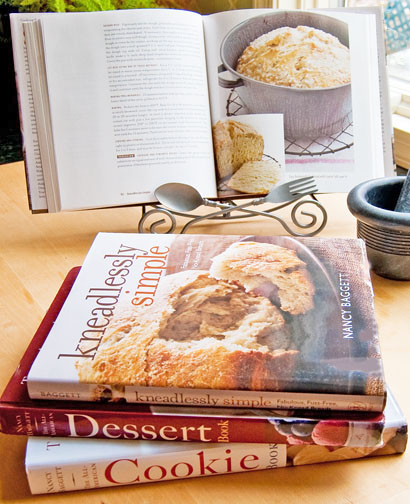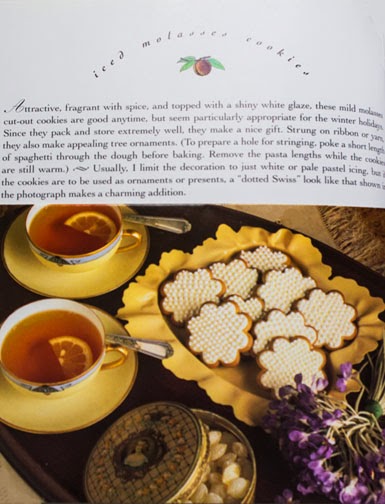I’m convinced that all recipes should have introductions, or as cookbook editors call them, “recipe headnotes.” I just finished 200 headnotes for my next book, so I’ve thought a lot about their purpose. I see each one as a special chance to connect with you my readers—you are right there at the top of the page, waiting to see what I have to say. So the intro is my opportunity to tell you why I care about this kind of food in general and this recipe in particular. (For some other tips on how to write tasty headnotes go here.)
Here’s an intro I especially like for a peach cobbler recipe. I hope it makes you hungry to read further, and maybe even tempts you to rush to the kitchen and make the dish.
When I asked around Mountain View, Arkansas, for the best home bakers, Jean Jennings’ name kept popping up. People would look heavenward, sigh blissfully and mention her cobbler. One musician friend of hers even told me, “Lordy, eatin’ her peach cobbler is better than sinnin’!”
There’s nothing wrong with introducing an occasional dish that way, but both editors and buyers will want to scream if every page of your cookbook or every recipe in your article starts with this same phrase.Do: Start with your personal take: “I really like this dish because….” Or at least invert your sentence order and begin with: “The perfect thirst quencher on a muggy day, this recipe is ….” Or better yet, tell a story—how you came upon the dish, or what inspired it, why it’s unusual, etc.

Don’t use “mouthwatering” or “delicious,” to describe your dish.
I’m tempted to say never, but certainly almost never. I never, ever use mouthwatering because Atlanta-Journal-Constitution writer John Kessler did a search and found that it was the most common food adjective used. I don’t want my writing to be that ordinary. Plus, the word “mouthwatering,” just doesn’t sound appetizing to me—sorry, but I picture drooling! As for delicious, I allow myself one per cookbook; it doesn’t tell the reader what is appealing about the food, which is really what a headnote should do.
Do: Think about how the dish is delicious: Is it juicy? Tender? Fragrant with spices? Silky on the tongue? Warming? Palate cleansing? There are hundreds of food adjectives and innumerable ways to say what a recipe tastes like; use them.
Example:
I adapted this boule from a terrific recipe shared with me by Craig Ponsford, founder of Artisan Bakers of Sonoma, California. Craig brought some of his gorgeous multigrain loaves to a baking conference, and, though I’m not normally a great fan of multigrain breads, I was bowled over by the unique earthy flavor, light but hearty texture, and handsome look of his loaves. The secret is the combination of nine different whole and ground grains and seeds, which adds a wonderful graininess and crunch, yet doesn’t hurt the teeth and completely avoids that earnest “it’s good for you so eat it,” character of some multigrain breads.
Don’t lie about the dish!
I recently gave one of my testers a recipe that was prefaced with some introductory notes I’d typed regarding how I’d liked the previous version. “This is so-so. A little bland. Also poor texture—dry and grainy.” I’d noted. “That’s your recipe intro?” my tester asked. No, it was in fact a road map to remind me of what needed to be improved before I could write my recipe intro. If I can’t honestly say something nice, I know I need to keep working on the recipe, or maybe decide to deep-six it.
Do: Focus on what you think is especially appealing, but also on what the reader may not like. I do this because I don’t see any point in people preparing a recipe they may not enjoy. So, I may say, “Since this sorbet is conveniently readied in a food processor , it’s texture won’t be quite a smooth as one made in an ice cream machine.” Or, “The fennel seeds give these breadsticks a pronounced licorice taste. If you aren’t wild about this flavor, you may want to reduce the amount to 1 teaspoon, or substitute caraway seeds for a different effect altogether.”
Example:
This is not your typical understated chocolate pudding! In fact, since it features not only chocolate but cayenne pepper, orange, cinnamon, and allspice, it’s at the far end of the spectrum from the comforting classic versions most folks are familiar with.
So there you have it. I hope this is your recipe for recipe intro success!


Wow! Excellent article. Thanks for sharing. When writing an interesting book about food, do not just simply make your readers hungry and crave the dishes and meals in your book. Teach them how to do these dishes and meals themselves so that they can satisfy their hunger and craving. Read my blog about How to Write an Interesting Book about Food?
Thanks
Regards
Anita
Thanks for getting in touch. Glad you found material that helped you. Enjoy the holidays! Nancy
very good site. The example is great and helpful.
Glad this was useful. I use the tips myself when doing all those recipe intros. It’s easy to get repetitious otherwise.
Whow! Nancy what a useful piece of information. I’ve just submitted my recipes for editing. Now I already know where I would need to make changes.
Thank you so much. I needed to hear some of the don’t and the dog ofcourse just to be sure.
Nancy — wonderful advice. As a cookbook editor, I would add just one more: Try not to use "this" and "these" — especially at the beginning of the headnote. (These cookies are… This cake will…) It gets very tiresome.
Great post! Wish I read this before I finished my first book!
This is a fabulous post, Nancy. I absolutely agree about the importance of headnotes. When I come across a book without them, I somehow feel neglected by the author–even if the recipes themselves look just fabulous. As readers (and as writers) we do need that personal take on why we should care about another bunch of ingredients thrown together.
Nancy,
Like your idea about introducing a recipe with a headnote. Makes it much more personal and use-friendly.
Thanks.
Helen
Hope the bars are a big hit and are just "delicious!" Thanks for dropping by….
Nancy, this post was amazing. I learned so much from it. I have to admit that on my blog, I use delicious ALL the time but now I know I can (should) do better than that. Thank you!!
Btw, I will be making your Caramel-Apple Crumb Bars tonight and taking them to a work potluck tomorrow. Can't wait!!!
Hanaâ
http://HanaasKitchen.blogspot.com
Hi Nancy,
Really good advice. I, too, can't stand the "mouth-watering" adjective (yuck!). And I often have to remember to think of something more interesting to say in blog posts instead of the rather boring and nondescript "delicious!" It's a fun challenge to come up with ways of talking about food that aren't themselves stale (pardon the pun!).
Love your books and I'm so glad to hear you're in the thick of working on a new one! What's the focus of the new book, and when can we expect it?
Thanks,
Jane
……..I just did, her name is Nancy Baggett!!!!!!!
Good luck on your book project. Glad I could be helpful. For headnote inspiration I suggest really studying some of cookbook writers you really like–you'll learn a lot.
Nancy – This is a great post, especially for someone like me. I have never written head-notes and your clear explanations and examples are great……..
I have not written a cookbook but might consider one in the future.
Thank you for sharing your knowledge and expertise………..